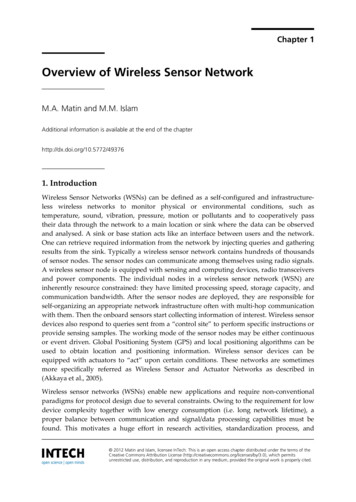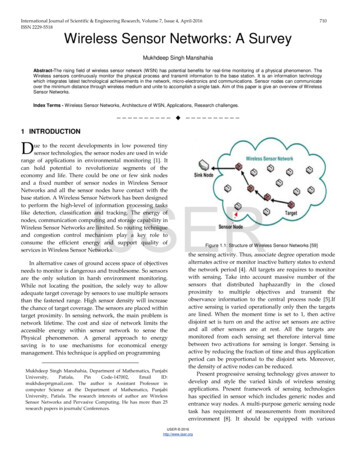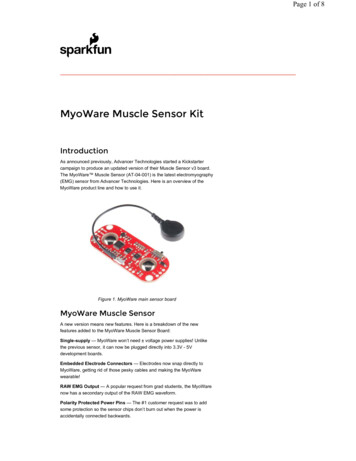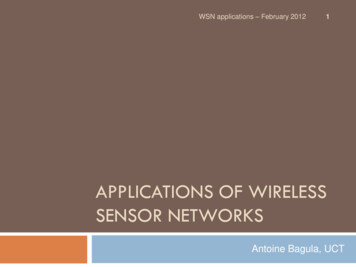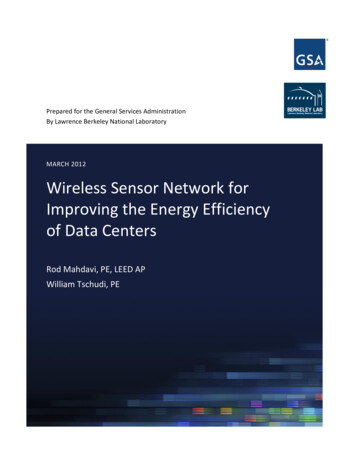
Transcription
Prepared for the General Services AdministrationBy Lawrence Berkeley National LaboratoryMARCH 2012Wireless Sensor Network forImproving the Energy Efficiencyof Data CentersRod Mahdavi, PE, LEED APWilliam Tschudi, PE
The Green Proving Ground program leverages GSA’s real estate portfolioto evaluate innovative sustainable building technologies and practices.Findings are used to support the development of GSA performancespecifications and inform decision-making within GSA, other federalagencies, and the real estate industry. The program aims to driveinnovation in environmental performance in federal buildings and helplead market transformation through deployment of new technologies.
DisclaimerThis document was prepared as an account of work sponsored by the United States Government. While thisdocument is believed to contain correct information, neither the United States Government nor any agencythereof, nor The Regents of the University of California, nor any of their employees, makes any warranty,express or implied, or assumes any legal responsibility for the accuracy, completeness, or usefulness of anyinformation, apparatus, product, or process disclosed, or represents that its use would not infringe privatelyowned rights. Reference herein to any specific commercial product, process, or service by its trade name,trademark, manufacturer, or otherwise, does not constitute or imply its endorsement, recommendation, orfavoring by the United States Government or any agency thereof, or The Regents of the University ofCalifornia. The views and opinions of authors expressed herein do not necessarily state or reflect those ofthe United States Government or any agency thereof, or The Regents of the University of California.The work described in this report was funded by the U.S. General Services Administration and the FederalEnergy Management Program of the U.S. Department of Energy under Contract No. DE-AC02-05CH11231.Contributors:United States Department of Agriculture (USDA): Jamie Boyle, Ron Jones, Diego Maldando, Greg Massey,and Steve VenegoniUnited States General Services Administration (GSA): Chris Cockrill, Zach Hawks, Mike Lowell, and KevinPowellSynapSense: Patricia Nealon and Ray PfeiferLawrence Berkeley National Laboratory (LBNL): Rod Mahdavi, Dale Sartor, Bill Tschudi, Mark WilsonFor more information contact:Kevin PowellProgram ManagerGreen Proving GroundOffice of the CommissionerPublic Buildings ServiceU.S. General Services Administration555 Battery Street, Room 518San Francisco, CA 94111-2312Email: kevin.powell@gsa.govWireless Sensor Network for Improving the Energy Efficiency of Data CentersPage i
Table of ContentsPageI.Executive Summary. 1II.Background . 2A. Introduction . 2B. Data Center Monitoring . 3III.Purpose . 3IV.Technology Description and Research Plan . 4A. Wireless Sensor Technology . 4B. Study Design . 4V.Assessment . 5A. Facility Description . 5B. Wireless Technology Specification . 5C. Technology Deployment . 6D. Technology Application . 6VI.Measured Results . 7A. Data Center Environmental Findings . 7B. Thermal Monitoring . 8C. Air Management and Air Distribution Metrics. 8D. Rack Cooling Index (RCITM/SM): . 8E. Return Temperature Index (RTITM/SM): . 9F. Data Center Temperature Analysis Using Thermal Maps . 10G. Relative Humidity Analysis and Map. 13H. Sub-Floor Pressure Analysis and Imaging Map . 14I.Rack Cooling . 15J.Data Center Air Handler Operational Behavior . 17K. Implementation of the Recommended Measures . 18VII. Summary Findings and Conclusions . 28A. Overall Technology Assessment at Demonstration Facility . 29B. Best Practices . 29C. Market Potential within the GSA Portfolio . 32D. Installation and Commissioning at Demonstration Facility . 32E. User Acceptance. 33F. Barriers and Enablers to Adoption . 33Wireless Sensor Network for Improving the Energy Efficiency of Data CentersPage ii
VIII. Appendix A - Assessment Kit Specification . 34Wireless Sensor Network for Improving the Energy Efficiency of Data CentersPage iii
I.Executive SummaryData centers occupy less than 2% of the federally owned portfolio under the jurisdiction, custody or controlof the U.S. General Services Administration (GSA), but represent nearly 5% of the agency’s overall energybudget. Assuming that energy use in GSA’s data centers tracks with industry averages, GSA can anticipatethat data center energy use will grow at an annual rate of 15%, a doubling of energy use every five years.1 Infact, energy is the single largest operating expense for most data centers. Improving the energyperformance of data center systems supports progress toward meeting federally mandated greenhouse gasemission-reduction goals, while reducing operating and energy costs and allowing for greater flexibility infuture expansion by eliminating the need to provide additional power and cooling.Studies sponsored by the U.S. Department of Energy (DOE) and the U.S. Environmental Protection Agency(EPA) have shown that energy use can be reduced by 25% through implementation of best practices andcommercially available technologies. The present study evaluated the effectiveness of a strategy to costeffectively improve the efficiency of data center cooling, which is the single largest non-IT load. Thetechnology that was evaluated consists of a network of wireless sensors—including branch circuit powermonitors, temperature sensors, humidity sensors, and pressure sensors, along with an integrated softwareproduct to help analyze the collected data. The technology itself does not save energy; however, itsinformation collection and analysis features enable users to understand operating conditions and identifyproblem areas. In addition, data obtained by this technology can be input into assessment tools that canidentify additional best practice measures. Energy savings result from the implementation of the bestpractices.The study was conducted to validate the premise that providing data center operators with detailed, realtime measurement of environmental parameters and power consumption enables them to establishbaseline performance, discover areas of sub-optimal performance, and identify concrete opportunities forimprovement. Real-time measured performance data was collected in a demonstration facility at the U.S.Department of Agriculture’s (USDA) National Information Technology Center (NITC) Data Center in St. Louis,Missouri, to validate the effectiveness of these improvements, enable further fine-tuning of systems, verifysavings, and report results. Wireless sensor technology was selected because, in contrast to wired sensortechnology, it can deliver the data in a cost-effective, facility-friendly way.2After wireless sensor technology was deployed at the demonstration facility, implementation of theidentified efficiency measures was used to reduce the data center’s cooling load by 48%, reducing total datacenter power usage by 17%. This represented an annual savings of 657 megawatt-hours (MWh). There wasalso a corresponding reduction in the data center’s Power Usage Effectiveness (PUE), from 1.83 to 1.51. Thedata center’s carbon footprint was reduced by 542 metric tons annually.The implications for broader deployment of this technology by tenant agencies in space managed by theGSA are significant. The GSA provides its tenants with space for more than 1,400 data centers.3 Although thetechnology was deployed only at a single demonstration facility, the actual results track closely withexpected results. The evaluation team is therefore confident that similar performance improvements can be1U.S. Environmental Protection Agency. 2007. Report to Congress on Server and Data Center Energy Efficiency Public Law109-431. ENERGY STAR Program. August 2, 2007.2Because of its high cost ( 1,000– 1,500 an installed node), no comparably dense network of wired sensors is feasible.3According to GSA's STAR database for Automated Data Processing (ADP) space, as of October 2011.Wireless Sensor Network for Improving the Energy Efficiency of Data CentersPage 1
achieved by deploying similar technology across all data centers within the GSA portfolio. The team projectsthe potential energy savings identified in Table 1 if such deployment by GSA’s tenants are achieved:PUEWatts/SquareFoot ITLoadUtility Cost( /kWh)Annual EnergySavings (kWh)Annual CostSavings ( )CarbonSavings(metric tons)Baseline1.94690.11n/an/an/aProjected ResultsUsing 0532,000Table 1. Projected Savings for the Entire GSA Portfolio5The study also confirmed the cost effectiveness of this technology. Even though energy costs at thedemonstration facility ( 0.045/kWh) were among the lowest in GSA’s portfolio, simple payback at the studylocation was calculated to be 3.4 years, based on a 101,000 cost (vendor provided hardware, software, andlabor).The most significant barrier posed by this technology was the multiple interruptions of facility powerrequired to safely connect power monitoring equipment at the demonstration facility. The evaluation team,working with SynapSense Corporation, the vendor that provided the technology, addressed this issue bydeveloping an assessment kit capable of capturing the most important information and efficiently deployingthe technology without facility power interruptions. The evaluation team recommends that this type oftechnology be used in facilities that wish to achieve energy savings using non-intrusive/non-interruptiveequipment. This technology supports a rapid assessment to identify energy efficiency measures, one ofwhich would likely be to install a full wireless monitoring system.In summary, the study validates the effectiveness of a dense network of wireless sensors to provide areliable, facility-friendly, cost-effective source of real-time information that enables data center operators toachieve 10% or greater improvements in overall data center efficiency. Dissemination of these findingsshould encourage the adoption of this technology throughout GSA and the data center industry.II. BackgroundA. IntroductionAs the nation’s single largest energy user and a significant energy consumer in many areas of the country,the federal government is keenly aware of the need not only to use energy efficiently, but also to invest inenergy-reduction measures that make good business sense while not interrupting operations. Recognizingthe pervasiveness of this problem, multiple mandates direct the Federal government to improve data centerefficiency.64This savings projection assumes an average 17% reduction in total data center energy use.Average numbers for the GSA portfolio according to GSA’s Office of Innovative Technology, as of October 2011.6Energy Independence and Security Act; Executive Orders 13514 and 13423; Energy Policy Act of 2005; Title 10 Code ofFederal Regulations 433.5Wireless Sensor Network for Improving the Energy Efficiency of Data CentersPage 2
To identify the energy-efficiency opportunities in data centers, and to stimulate the adoption of measuresthat address them, DOE developed an energy assessment process, along with assessment tools to help datacenter stakeholders identify energy-efficiency measures. The DOE’s Federal Energy Management Program(FEMP) and GSA are promoting the use of energy assessments to discover efficiency opportunities that canlead to dramatically improved energy performance while maintaining or improving data center reliability.B. Data Center MonitoringPerforming accurate assessments and benchmarking, however, requires knowledge of the data center’soperation, monitoring of multiple environmental parameters (such as temperature, dew point, and pressurein the data center at many locations and elevations), and metering of electrical power, from the electricalsub-station to its end use. To monitor so many parameters through a conventional wired monitoring systemis expensive and logistically difficult. The cost of such hard-wired systems ranges from 1,000 to 1,500 persensor node, and this rarely yields a feasible payback. Recent advances in wireless technology, however,enable wireless sensor networks to achieve equivalent performance at a projected cost of 100 to 150 pernode.7 Moreover, wireless systems eliminate the key logistical barrier of placing additional wiring inovercrowded racks. Because they are easily expandable and relocatable, wireless systems also provideflexibility to grow and adapt as a data center evolves over time. There are multiple vendors selling wired andwireless monitoring and control systems for data centers, and there is certainly a market for these systems.III. PurposeWith input from industry, the DOE Industrial Technologies Program’s8 (DOE ITP) Save Energy Now initiativedeveloped a suite of assessment tools (DC Pro Software Tool Suite), that is useful for assessing data centerenergy use and identifying potential energy-efficiency measures. These tools, when used with therecommended assessment process, are most effective if implemented with monitored real-time data.9 Thehigh cost and logistical constraints of deploying a wired sensor network, however, provided a significantbarrier to capturing such data. Through an Interagency Agreement between GSA and DOE, LawrenceBerkeley National Laboratory (LBNL) worked with SynapSense to demonstrate that a wireless sensornetwork could be installed rapidly and at low cost, to facilitate delivery of the projected savings.The Green Proving Ground (GPG) program, under direction of the Public Building Service’s Office of the ChiefGreening Officer, was created to evaluate precisely such innovative technologies. The goal of this GPGtechnology evaluation was to learn whether such a wireless sensor network could provide the real-timepower monitoring and thermal mapping of the data center needed to visualize problems, identify solutions,and optimize the facility’s air flow management. It also sought to document that energy could be saved in acost-effective, facilities-friendly way.7Hard-wired cost estimate is based on experience of LBNL engineers. Projected wireless sensor cost estimate is based ondiscussions with vendors.8The DOE Industrial Technologies Program is now the DOE Advanced Manufacturing Office (AMO).9The DOE assessment resources are available from the following DOE websites: Assessment centers/pdfs/data center assessment process.pdf); Metering Protocol(http://www1.eere.energy.gov/femp/pdfs/hpc metering protocol.pdf); Data Collection acollectionprotocol.pdf).Wireless Sensor Network for Improving the Energy Efficiency of Data CentersPage 3
IV. Technology Description and Research PlanA. Wireless Sensor TechnologyThe wireless sensor technology installed and evaluated as part of this project consists of sensor nodes,gateways, routers, server platforms, and software applications. Specifically, this wireless sensor technologyenables data center operators to:Establish baseline energy utilization and identify improvement opportunities using the DC ProSoftware Tool Suite.Monitor and validate energy-saving measures following the implementation of improvements.Measure real-time energy end use and calculate PUE with accurate power measurements.Interpret temperature, humidity, and subfloor pressure differential data from hundreds of sensornodes using intuitive live-imaging maps.Measure power (and use it to calculate energy) and incorporate other sources of data, such asbuilding automation system (BAS) data.Monitor environmental conditions to help ensure that they stay within ranges recommended by theAmerican Society of Heating, Refrigerating and Air-Conditioning Engineers (ASHRAE) and providealerts if the ranges are exceeded.B. Study DesignThe wireless sensor technology that was evaluated consists of hardware and software that collects andanalyzes data that can be used to help identify efficiency improvements in data centers, including those thatare already considered energy efficient. To measure and validate performance claims for this technology,the study team identified a well-designed and well-managed data center for this demonstration project. Thelocation selected, the USDA’s National Information Technology Center Data Center in St. Louis, Missouri, hada baseline PUE of 1.83 (Figure 1). It utilizes traditional computer room air conditioning (CRAC) units and hasa highly motivated, engaged, and knowledgeable facility operator.The NITC facility is a Tier 3 data center located at the GSA Goodfellow Federal Complex. The data center is ina general-purpose office building that houses a number of USDA departments, including a local USDA Officeof the Chief Information Officer (OCIO) data center. The facility includes two raised-floor rooms separatedby under-floor barriers. To accommodate future expansion of the NITC data center, the OCIO designed andconstructed an expansion data-center room adjacent to the existing data center space.While the scope of the energy assessment was the entire NITC data center facility, including the newlyconstructed expansion space, the wireless sensor network deployment was limited to one room of the datacenter facility (demo room).The demonstration consisted of deploying a self-configuring, multi-path network (mesh network)10 ofwireless sensors that provide real-time measurement of server inlet temperature and sub-floor pressuredifferential. Analytics based on mapping of the sensor data helped identify improvements for more energyefficient cooling of the IT equipment. The total average electrical demand for the NITC data center during10A wireless mesh network (WMN) is a communications network made up of nodes organized in a mesh topology. A meshnetwork is reliable and offers redundancy. When one node can no longer operate, the rest of the nodes can stillcommunicate with each other, directly or through one or more intermediate nodes.Wireless Sensor Network for Improving the Energy Efficiency of Data CentersPage 4
the 11-day baseline period (June 14–24, 2010) was 434.6 kilowatts (kW), which equates to an annualizedenergy use of 3.81 gigawatt-hours per year (GWh/yr). During the baseline period, approximately 55% of thetotal energy use was for the IT equipment.Figure 1. NITC Data Center Power Utilization Effectiveness (PUE) (Center Number 24)Compared to Other Data Centers Benchmarked by LBNLV. AssessmentA. Facility DescriptionThe NITC data center facility has 18,600 square feet (sf) of raised floor area with approximately 13,050 sf(70%) currently built out. Cooling for the three raised floor rooms that comprise the NITC data center isprovided by eight down-flow CRAC units in the data center demo room; four CRAC units in the expansionroom (two units were previously shut off); and two CRAC units in the TELCO/Tape Storage room.These glycol-cooled CRAC units provide cooling and humidification for the data center raised floor and areequipped with dual direct-expansion (DX) compressors, glycol condensers, electric reheat coils, and infraredhumidifiers. These units also provide cooling for the uninterruptible power supply (UPS) units that arelocated on the data center raised floor. Each CRAC has an associated glycol circulation pump located in amechanical penthouse on the roof to supply their cooling.B. Wireless Technology SpecificationWorking with the wireless vendor, SynapSense, LBNL identified standard specification requirements for suchsensor networks. Requirements included the following:The wireless system should be robust and reliable for use in industrial environments, which typicallyhave a large amount of radio frequency (RF) noise. In data centers, this noise is created by servers,UPS inverters, and building systems, as well as other wireless communications, such as Wi-Fi andmobile phones, all of which create interference that can significantly degrade network performance.Time, frequency, and physical diversity should be incorporated to assure reliability, scalability,power source flexibility, and ease of use.A “manager” (gateway) should coordinate routing, aggregate packets, collect network statistics, andhandle all data transfers. There should be a wireless connection between the manager and its meshnetwork, and a hard-wired connection to the server.Wireless Sensor Network for Improving the Energy Efficiency of Data CentersPage 5
The sensor nodes should be ultra low-power wireless transceivers that transfer data to and fromintegrated sensors or controllers, and use an on-board radio to send the packets to neighboringnodes to eliminate operational interference.For security, the wireless sensor, router, and gateway devices should not support any IP-basedprotocols.Data latency should be minimized to achieve data reliability of the wireless network at least on theorder of 99.999%.The wireless network should be able to accommodate feedback (i.e., data flow from upstream andback).Environmental monitoring should provide real-time visualization of air distribution and mixing.Although there are a number of additional parameters that can be monitored with the wireless sensors(e.g., particulates), only temperature, humidity, pressure differential, and electrical power are included forenergy assessments in most data center applications.A graphic summary of a typical system is shown in Figure 2.C. Technology DeploymentA total of 588 environmental sensors were installed throughout the demo room: 16 temperature and 16humidity sensors were installed in the CRAC units, and 420 temperature sensors were located at the top,middle, and bottom of computer racks measuring air intake and exhaust conditions at the IT equipment.Additional sub-floor reference temperatures were monitored at selected racks. Sixty humidity/temperaturesensors were located at the top of selected racks. Eighteen pressure sensors were located throughout thedemo room. In addition, eleven power meters were installed strategically on main power distributionpanels. The balance of the system included routers and a gateway that was connected to a server.Figure 2. Typical Monitoring SolutionsD. Technology ApplicationAfter the network was fully commissioned, data were gathered and analyzed by a qualified assessor. Resultswere used to create an accurate understanding of the data center operation, and the measured data wereinput into the DC Pro Software Tool Suite. The output from the assessment tools provided recommendationsWireless Sensor Network for Improving the Energy Efficiency of Data CentersPage 6
on specific potential energy savings opportunities. With the measured data and the output from the DC ProSoftware Tool Suite, the assessor was able to identify high-value energy-efficiency measures. As measureswere implemented, the improvement in PUE was readily determined by the wireless monitoring system.Broadly, energy-efficiency measures fell into two categories:Airflow Distribution OptimizationoChanging all remaining IT alignment to conform with a hot aisle/cold aisle configurationoInstalling missing blanking plates in the IT equipment racksoTurning off and covering three CRAC units to reduce by-pass airoRebalancing the perforated floor tiles using the rack inlet air temperature sensors to matchthe IT equipment air flow and cooling demandCooling Efficiency MeasuresoRaising CRAC return air temperature set points from 64 F–68 F to 72 F, 3 F, to increasethe sensible cooling capacity of the units and decrease the over-cooling occurring in theroomoLowering CRAC return relative humidity (RH) set points from 46% RH to 30% RH, 5% RHoTurning off CRAC dehumidification and reheat modes to eliminate simultaneoushumidification and dehumidificationAfter each trial, the wireless monitoring system immediately showed the impact of the changes, providingencouragement for additional trials.VI. Measured ResultsA. Data Center Environmental FindingsThe initial field assessment of the NITC data center demo room revealed several energy-efficiency designand operational best practices already in place. These are highlighted below:IT equipment racks were, for the most part, installed in hot aisle/cold aisle orientation.The majority of cable penetrations under equipment racks were sealed, as were power and cablingpenetrations in the sub-floor barriers between adjacent data center rooms.In addition to visual observation of the data center, findings were based on analysis of the data collectedduring the baseline monitoring period. The SynapSense software, which provides historical analysiscapabilities as well as console navigation and data center alarms and alerts, was used to complete theassessment. Much of the analysis presented in this report, including the graphical images, was provided bySynapSense and is included with its consent.The analysis included the following:Analysis of key data center air management and air mixing metrics.Analysis of thermal and relative humidity pressure conditions. The aggregation of real-time dataenabled the evaluation team to produce thermal maps that visually captured the environmentalstate of the data center at a given date and time. These maps helped quickly identify possibleproblem areas in specific locations of the data center.Wireless Sensor Network for Improving the Energy Efficiency of Data CentersPage 7
Analysis of temperature, RH, and dew point (DP) conditions at individual rack levels. The rack levelanalysis showed thermal, RH, and dew point conditions over time and helped to identifyovercooling, overheating, and air mixing conditions in specific racks or aisles.Analysis of temperature, RH, dew point, and fan/humidification energy were used to identify coolingefficiency of the individual cooling systems.B. Thermal MonitoringTemperature sensors were installed on selected racks, to provide temperature readings for identifying hotspots, to measure the level of overcooling, and to quantify the level of recirculation and by-pass air mixingoccurring in the data center.During the baseline period, the central cooling systems were being operated to control supply airtemperature to maintain rack inlet air temperature within the ASHRAE-recommended guidelines. TheASHRAE 2011 ranges11 are shown in Table 2:ASHRAE 2011 Recommended RangesLow-End T
Wireless sensor technology was selected because, in contrast to wired sensor technology, it can deliver the data in a cost-effective, facility-friendly way.2 After wireless sensor technology was deployed at the demonstration facility, implementation of the identified efficiency measures was

